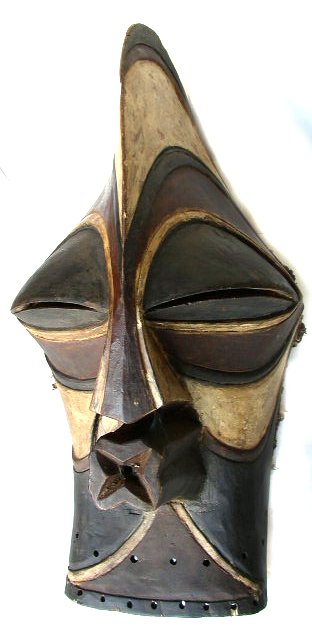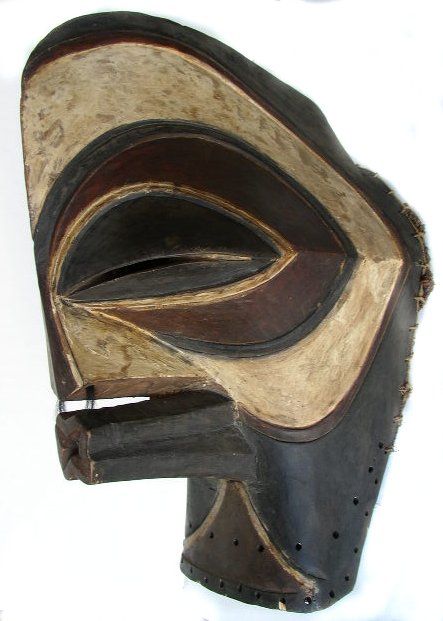 Kifwebe male mask. The 150,000 Songye live in the
southeast of the country. The Songye traditionally relied mostly on farming and hunting
for subsistence. Because the rivers were associated with the spirits of deceased chiefs
who were often buried in them, fishing was not practiced except in times of great need.
In the Songye language, a mask is a kifwebe; this term has been given to masks representing spirits. The kifwebe
society used them to ward off disaster or any threat. The mask had also the capacity to
heal by means of the supernatural force it was supposed to incorporate. The masks,
supplemented by a woven costume and a long beard of raffia bast, dance at various
ceremonies. Mask, colors, and costume all have symbolic meaning. The use of white on the
mask symbolizes positive concepts such as purity and peace, the moon and light. Red is
associated with blood and fire, courage and fortitude, but also with danger and evil. The
dancer who wears the male mask will display aggressive and uncontrolled behavior with the
aim of encouraging social conformity, whereas the dancer who wears the female mask display
more gentle and controlled movements and is assumed to be associated with reproduction
ceremonies. The female mask distinguishes from the
male one by the absence of a crest on top of the head.
Kifwebe male mask. The 150,000 Songye live in the
southeast of the country. The Songye traditionally relied mostly on farming and hunting
for subsistence. Because the rivers were associated with the spirits of deceased chiefs
who were often buried in them, fishing was not practiced except in times of great need.
In the Songye language, a mask is a kifwebe; this term has been given to masks representing spirits. The kifwebe
society used them to ward off disaster or any threat. The mask had also the capacity to
heal by means of the supernatural force it was supposed to incorporate. The masks,
supplemented by a woven costume and a long beard of raffia bast, dance at various
ceremonies. Mask, colors, and costume all have symbolic meaning. The use of white on the
mask symbolizes positive concepts such as purity and peace, the moon and light. Red is
associated with blood and fire, courage and fortitude, but also with danger and evil. The
dancer who wears the male mask will display aggressive and uncontrolled behavior with the
aim of encouraging social conformity, whereas the dancer who wears the female mask display
more gentle and controlled movements and is assumed to be associated with reproduction
ceremonies. The female mask distinguishes from the
male one by the absence of a crest on top of the head.
Material: wood, vegetable fiber, feathers
Size: H. 25”, W. 11”, D. 15½”

 Kifwebe male mask. The 150,000 Songye live in the
southeast of the country. The Songye traditionally relied mostly on farming and hunting
for subsistence. Because the rivers were associated with the spirits of deceased chiefs
who were often buried in them, fishing was not practiced except in times of great need.
In the Songye language, a mask is a kifwebe; this term has been given to masks representing spirits. The kifwebe
society used them to ward off disaster or any threat. The mask had also the capacity to
heal by means of the supernatural force it was supposed to incorporate. The masks,
supplemented by a woven costume and a long beard of raffia bast, dance at various
ceremonies. Mask, colors, and costume all have symbolic meaning. The use of white on the
mask symbolizes positive concepts such as purity and peace, the moon and light. Red is
associated with blood and fire, courage and fortitude, but also with danger and evil. The
dancer who wears the male mask will display aggressive and uncontrolled behavior with the
aim of encouraging social conformity, whereas the dancer who wears the female mask display
more gentle and controlled movements and is assumed to be associated with reproduction
ceremonies. The female mask distinguishes from the
male one by the absence of a crest on top of the head.
Kifwebe male mask. The 150,000 Songye live in the
southeast of the country. The Songye traditionally relied mostly on farming and hunting
for subsistence. Because the rivers were associated with the spirits of deceased chiefs
who were often buried in them, fishing was not practiced except in times of great need.
In the Songye language, a mask is a kifwebe; this term has been given to masks representing spirits. The kifwebe
society used them to ward off disaster or any threat. The mask had also the capacity to
heal by means of the supernatural force it was supposed to incorporate. The masks,
supplemented by a woven costume and a long beard of raffia bast, dance at various
ceremonies. Mask, colors, and costume all have symbolic meaning. The use of white on the
mask symbolizes positive concepts such as purity and peace, the moon and light. Red is
associated with blood and fire, courage and fortitude, but also with danger and evil. The
dancer who wears the male mask will display aggressive and uncontrolled behavior with the
aim of encouraging social conformity, whereas the dancer who wears the female mask display
more gentle and controlled movements and is assumed to be associated with reproduction
ceremonies. The female mask distinguishes from the
male one by the absence of a crest on top of the head. 